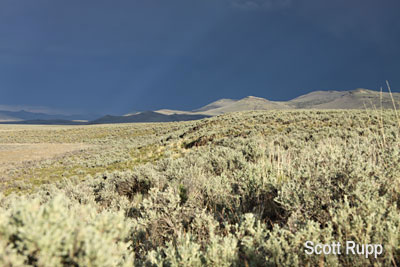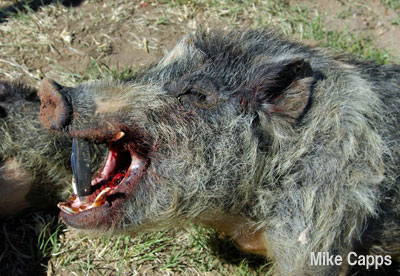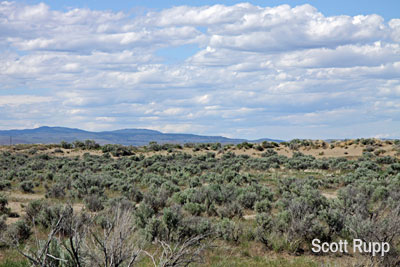
I ran over the sandy soil at a dead sprint, dodging waist high clumps of sagebrush and jumping over badger holes big enough to swallow my leg and snap the bone. Several hundred yards ahead of me, the two dogs barked, loud and excited, on the hunt, while the grunts and squeals of a lone hog echoed over the sagebrush. I couldn’t make them out, yet, though the three animals seemed to be moving along a low ridgeline to my left.
I hadn’t run for more than two minutes and already it was getting hard for me to breathe in the dry air of Eastern Oregon’s high desert. We were at some 4,600 feet in elevation, nearly 3,000 feet higher than back home in Wisconsin, and my lungs weren’t used to the altitude.
Holding my Mossberg MMR Tactical Rifle across my chest at port arms, I told myself, “Run, damnit, run.”
“Get ‘em, Boys!” friend and local hunter Duane Freilino yelled out to the dogs. “Don’t let him go!”
Duane was ahead of me 50 yards. These were his dogs, and they’d located the second wild hog of the morning. As I got closer to the action, I saw the large black body of Buckshot, a full-blooded Catahoula male, flash between the dusty green of the sagebrush, while the hog’s enraged grunts got louder. I caught sight of the hog briefly, brownish-grey and short.
A minute later I stood next to Duane, trying to catch my breath as I watched the two dogs nip at the flanks of the hogs. The smallish boar, though, was having none of it, expertly dodging the dogs, using the sagebrush bushes to block, and swinging his head from side-to-side to hook and tear the dogs with a set of very sharp cutters.
“You ready?” Duane asked, grinning.
“Let’s do it!” I said.
Duane called the dogs off, and Buckshot came running to us. But not Six, a year and a half old Catahoula and cur mix. Six kept biting at the hog, while the small boar put his back to some sagebrush and swung those cutters. Duane yelled and yelled, but Six wouldn’t break away.
Duane slid in close, trying to get a hand on Six’s collar, and had to scramble away more than once as the fighting pair nearly rolled over him. When he finally managed to pull the dog off and back away, the boar stood was less than 20 yards from me.

I made sure the scope was on the lowest setting and snapped the safety off the MMR. The boar began to move out of the sage, snorting and twisting around, anticipating the dog. As if he sensed someone was there, the boar spun around and faced me, looking me up and down. He was winded and angry, his blood at full boil. I stepped to my right, not wanting a full-on head shot, trying for an opening in his shoulder area. But the boar shifted along with me.
The hog raised his head and lowered it several times, his small eyes locked on me the whole time. I had the distinct feeling he was trying to decide if he should charge me or not – me all of 15 yards away at this point – when one of the dogs Duane was holding bayed. The boar craned his head to one side briefly at that sound. I snapped the crosshairs of my Swarovski Z5 scope onto that space between his neck and shoulder and squeezed the trigger.
The boar hit the ground immediately. The MMR is a .223 caliber rifle, Mossberg’s entry into the AR market and a heck of a nice rifle (I’ll have a MMR review in an upcoming SHWAT™ blog). I was using 50 grain Winchester Ballistic Silver Tips. One was all it took. The bullet has a polymer tip and an alloyed lead core, and with its Lubalox black oxide coating, the bullet is made to blast through tough material and then expand aggressively. It did all of that. The boar didn’t even roll over, grunt, or flap an ear. Done.
Just after six in the morning. The sun washing over the sage brush. Two hogs down. Tactical hog hunting in the high desert of Oregon. Man, oh man!
I was in Eastern Oregon, about 30 miles southeast of the city of Burns, thanks to an invite from Mossberg, Swarovski, Birchwood Casey, and Winchester Ammunition. This was a varmint hunt for badgers, rock chucks, ground squirrels and coyotes. Before I’d left, I checked the National Feral Swine Mapping System, run out of the University of Georgia, but funded by the U.S. Department of Agriculture. That map said they were no hogs reported within 50 miles of where I would be hunting.
I also studied the Oregon Department of Fish and Wildlife’s website. That had no map of feral hogs in the state. In fact, the website pretty much insisted there were darned few of the wild porkers running around. Though it did admit that, “The major feral swine activity in Oregon is generally located in near Madras, Maupin, Fossil, Spray and Mitchell—the hot bed of activity being a large circle around the Antelope area.”
 That “hot bed” was over 100 miles from where I put down the two hogs.
That “hot bed” was over 100 miles from where I put down the two hogs.
We were staying in Burns proper, and as soon as I got there I began asking people: “Any wild hogs around here?” I got a lot of shrugs and, “I don’t know.” Until I asked Duane. “Hell, yes,” he said, eager and ready. “Got some mutants you wouldn’t believe. Want to go out with me and my dogs tomorrow morning, see if we can’t take down a few?”
Here’s the story Duane told me. About five years ago, a local who raised Vietnamese pot-bellied pigs got the idea to cross the small pigs with a big old Russian boar. It worked! Too well, though, as the resulting progeny began escaping. Once out in the wilds, the ferals apparently found each other and have created a self-sustaining population. So far, Duane and his dogs have taken down 30 of what he calls, “Mutant little freak pigs.” Other ranches have killed them, too.
These are smaller hogs, usually under 100 pounds. Their heads show the Russian boar influence. They have compact, heavy bodies, and these short, stubby legs, attesting to the pot-bellied side of their family tree.
You wouldn’t think the high desert of Eastern Oregon would be a hog friendly environment, with its sandy soils dotted with sage brush and scrub. Summers are very hot and extremely dry. Winters? Deep snows, high winds and sub-zero temperatures often hammer the area.
But feral hogs adapt well. Within a couple years of the first escapes of the pot-bellied-Russian mixes, local farmers and ranchers started complaining. The hogs were tearing into their alfalfa “pivots,” the huge irrigated circles where they grow forage for their cattle. They were also ripping into their baled hay, and generally causing problems.
They are smart, too.
“You’d think a pig would run when he hears a pickup coming down the road,” Duane said to me. “No, sir! They’re coyote smart. They lay right down on their bellies in the sagebrush and wait ‘til you pass!”
I’d shot the first hog maybe 10 minutes before the second one, near an alfalfa pivot. The dogs bayed as soon as they jumped off the back of the pickup truck, the hog’s smell clear and close. In my mind’s eye I can see it: a swirling melee of dogs, a small boar grunting furiously, Duane trying to get his dogs off so that I, off to the side, can get off a shot. Duane got the dogs clear, yelled, “Take him!” The hog smashed through a sagebrush bush, hit the ground, spun, and looked me right in the eyes.
I shot him at maybe 12 feet with the MMR, didn’t even use the scope. One shot in the ribs and he was dying as he fell over on his side. I must admit, I got a little shaky afterwards. That pig wasn’t huge by any means—but a dozen feet away from any enraged hog is not a good zip code!
 Later, I looked over the two boars up close. Each weighed around 70 pounds. In Texas or Oklahoma, where I’ve killed pigs in the past, hogs this size and weight would be a year old, probably younger. But while the cutters on these Eastern Oregon mutants were not long, maybe two inches, they were very well formed, and extremely sharp. In other words, these were adult boars, small though they were. Duane estimated they were two and half to three years old, each.
Later, I looked over the two boars up close. Each weighed around 70 pounds. In Texas or Oklahoma, where I’ve killed pigs in the past, hogs this size and weight would be a year old, probably younger. But while the cutters on these Eastern Oregon mutants were not long, maybe two inches, they were very well formed, and extremely sharp. In other words, these were adult boars, small though they were. Duane estimated they were two and half to three years old, each.
Duane and I have been in touch since that hog hunt, which occurred in early June of this year. Recently, a rancher who lives some 30 miles west of Duane asked Duane for some hog eradication help.
“They are destroying his crops,” Duane says. “He asked me to come over and hunt the river bottom, on horseback, with my dogs. I told him I am ready to go when he calls. There are honest to God 300-pound hogs in that sounder!”
Three hundred pounds? So they’re not pot bellies?
“These are Russian crosses, big, black, and ugly,” Duane says.
I just rechecked my Oregon map and websites. There aren’t supposed to be any wild hogs there, either…!
Note:
When not ranching or chasing down wild hogs, Duane Freilino offers guided varmint hunts and gunsmithing though his business, Shooters Services Unlimited:


How does one get in on this action?
Dan, that’s different for everyone. Outfitters is the easy answer. Especially, if you’re not close to such an area.
Outfitters link is non-op and for sale